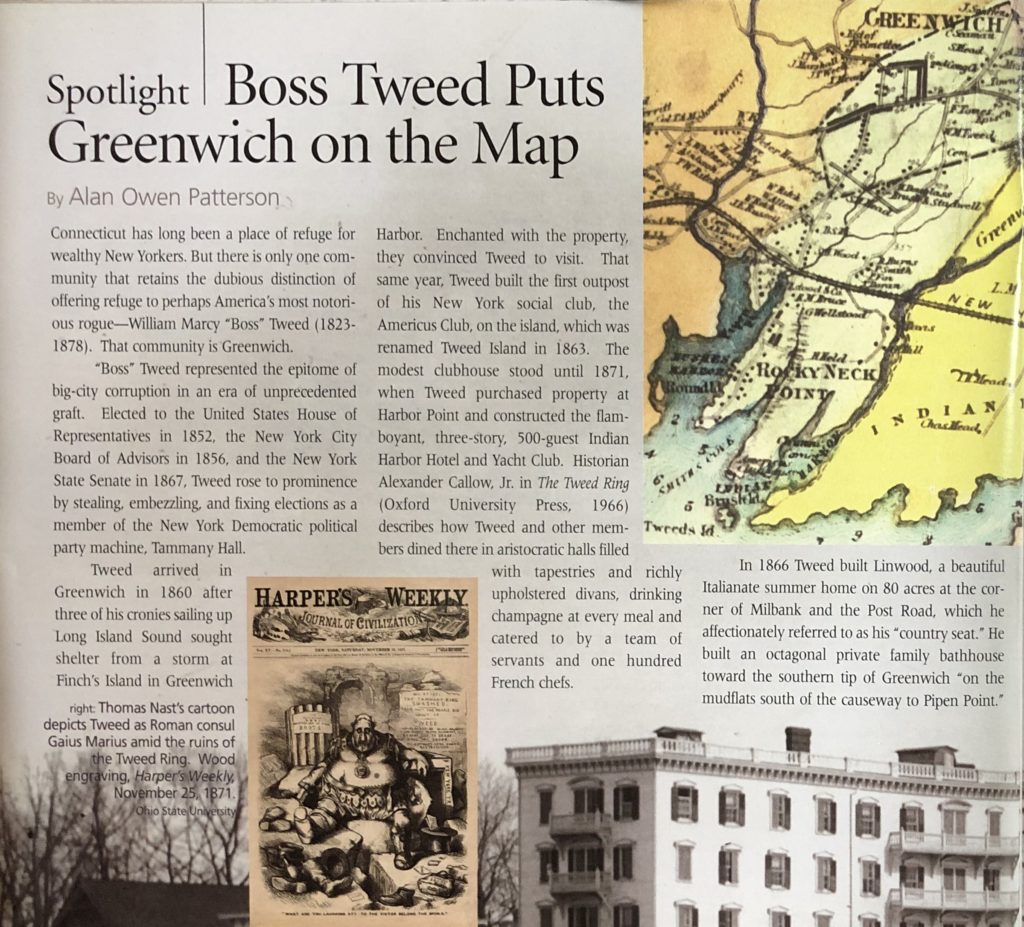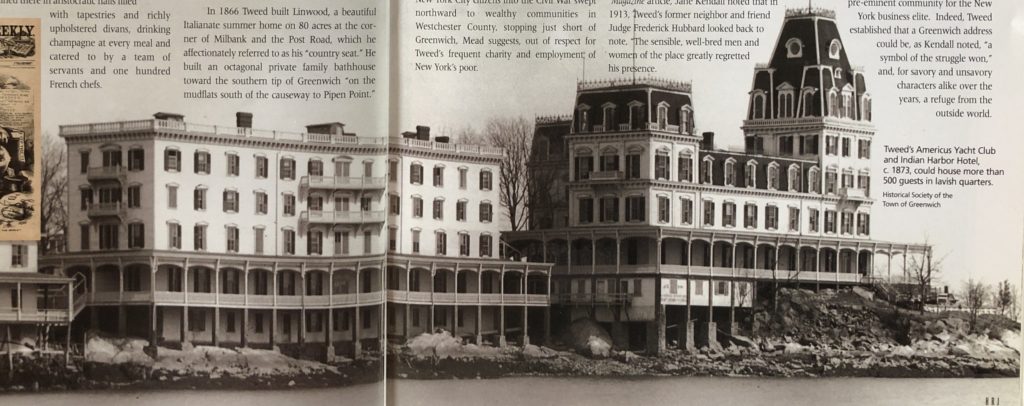(c) Connecticut Explored Inc. Winter 2008-2009
Subscribe/Buy the Issue!
Connecticut has long been a place of refuge for wealthy New Yorkers. But there is only one community that retains the dubious distinction of offering refuge to perhaps America’s most notorious rogue—William Marcy “Boss” Tweed (1823-1878). That community is Greenwich.
“Boss” Tweed was the epitome of big-city corruption in an era of unprecedented graft. Elected to the United States House of Representatives in 1852, the New York City Board of Advisors in 1856, and the New York State Senate in 1867, Tweed rose to prominence by stealing, embezzling, and fixing elections as a member of the New York Democratic political party machine, Tammany Hall.
Tweed arrived in Greenwich in 1860 after three of his cronies sailing up Long Island Sound sought shelter from a storm at Finch’s Island in Greenwich Harbor. Enchanted with the property, they convinced Tweed to visit. That same year, Tweed built the first outpost of his New York social club, the Americus Club, on the island, which was renamed Tweed Island in 1863. The modest clubhouse stood until 1871, when Tweed purchased property at Harbor Point and constructed the flamboyant, three-story, 500-guest Indian Harbor Hotel and Yacht Club. Historian Alexander Callow, Jr. in The Tweed Ring (Oxford University Press, 1966) describes how Tweed and other members dined there in aristocratic halls filled with tapestries and richly upholstered divans, drinking champagne at every meal and catered to by a team of servants and one hundred French chefs.
In 1866 Tweed built Linwood, a beautiful Italianate summer home on 80 acres at the corner of Milbank and the Post Road, which he affectionately referred to as his “country seat.” He built an octagonal private family bathhouse toward the southern tip of Greenwich “on the mudflats south of the causeway to Pipen Point.” He brought telegraph service to Greenwich in 1861 (presumably to hear news of the war and New York politics), arranged the first steamship service in 1866, and opened a saloon at Rocky Neck Point.
The Indian Harbor Hotel and Yacht Club notwithstanding, Greenwich appeared to provide Tweed with the opportunity to lead a quieter life out of the limelight. He never involved himself in Greenwich politics. He quietly donated money to local churches for construction and refurbishment. He brought children from New York’s Hart and Randall Island orphanages to his estate to enjoy the country air. In a 1994 Greenwich Time article, local historian Jeffery B. Mead speculated, in a story that may be more myth than truth, that in 1863 Tweed may have used his influence with labor leaders to save Greenwich from draft rioters. Cutthroat mobs and gangs protesting the drafting of poor New York City citizens into the Civil War swept northward to wealthy communities in Westchester County, stopping just short of Greenwich, Mead suggests, out of respect for Tweed’s frequent charity and employment of New York’s poor.
In 1873, Tweed was arrested for graft but escaped and fled the country, making it all the way to Spain—but not before a stop in Greenwich. In The Tweed Ring, Callow reported the Cos Cob station agent saw the fugitive Tweed get off the train. The agent could have turned him in for the $50,000 reward; when asked why he did not, he said he “just couldn’t.” Tweed’s obituary in the Greenwich Observer (April 13, 1878) suggested a sympathetic sentiment for him when it noted, “In the zenith of his political power, he was liberal, large hearted, and unselfish.” Tweed however, eventually was apprehended, convicted, and sentenced to prison.
Not all Greenwich residents shared such a glowing remembrance of Tweed. Upon hearing at a local town meeting of his conviction, officials rescinded a vote from two weeks earlier to abate Tweed’s property taxes. And in a 1993 Greenwich Magazine article, Jane Kendall noted that in 1913, Tweed’s former neighbor and friend Judge Frederick Hubbard looked back to note, “The sensible, well-bred men and women of the place greatly regretted his presence. They felt the town could not grow in wealth and character so long as he remained to make it notorious.”
None of Tweed’s properties exist today. The Indian Harbor Hotel and Yacht Club was demolished in 1895. Linwood was sold in 1878, moved, and then razed in 1930. Gone, too, are the bathhouse and saloon. Today there are no markers or evidence that Tweed ever lived in Greenwich, except that Tweed Island retains its name. This may not be by chance. Linwood was bought by Republican Greenwich philanthropist Jeremiah Milbank, who may not have appreciated Tweed’s Democratic association, while The Indian Harbor Hotel and Yacht Club was demolished by Commodore E.C. Benedict, a Wall Street financier and friend of Democrat (though not of the Tammany ilk) Grover Cleveland.
Tweed once predicted that within 25 years of his arrival, Greenwich would become the pre-eminent community for the New York business elite. Indeed, Tweed established that a Greenwich address could be, as Kendall noted, “a symbol of the struggle won,” and, for more than a few unsavory characters over the years, a refuge from the outside world.
Alan Owen Patterson teaches social studies at Conard High School in West Hartford and interned with Connecticut Explored as a graduate student at CCSU.
Explore!
Read more Connecticut true crime stories in our Fall 2016 issue.


